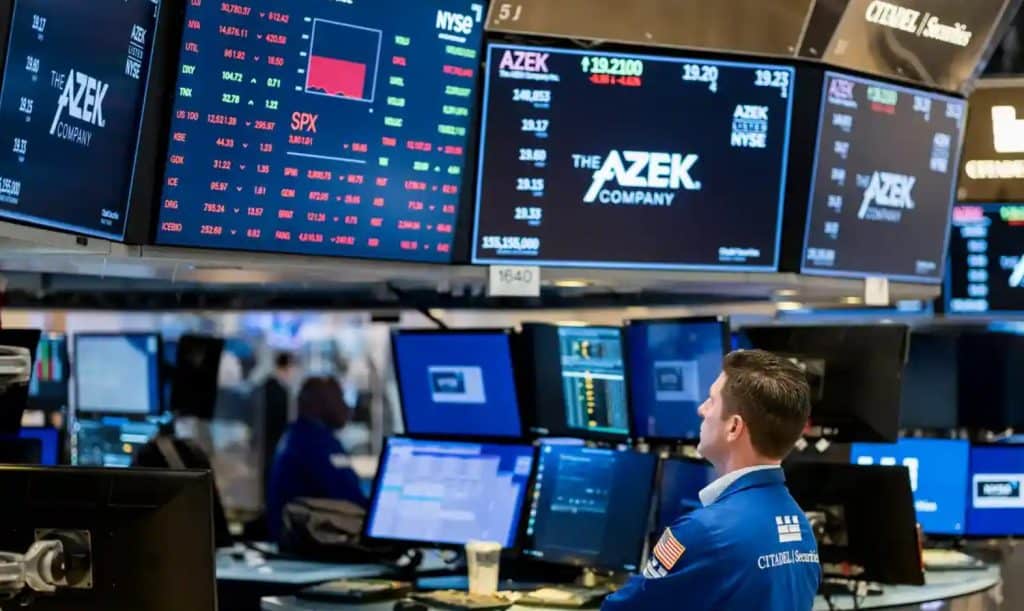
Fears about a possible recession have pounded stock markets around the world amid reports that US Federal Reserve could raise interest rates by as much as 0.75% this week – its biggest single hike in borrowing costs for nearly 30 years.
As Wall Street’s benchmark S&P 500 index fell almost 4% on Monday into bear territory, prompting selloffs from Sydney to Shanghai, US central bank policy makers will begin a two-day meeting on Tuesday with expectations mounting that they will lift rates by at least 0.50%.
But the Wall Street Journal reported on Monday that persistent inflation in the US – it touched 8.6% in May according to figures released on Friday – could lead the Fed to raise its short-term interest rate by three-quarters of a percentage point. That’s triple the usual amount and something the Fed hasn’t done since 1994. Traders now see a 34% probability of such a hike, up from just 3% a week ago, according to CME Group.
Economists at JP Morgan and Goldman Sachs immediately upped their estimates for the Fed’s decision – due to be announced on Wednesday – to an increase of 0.75%.
Such a move would pile pressure on other central banks to raise rates and many analysts fear that could choke off the post-pandemic recovery in the global economy and lead to recession.
Chris Beauchamp, chief market analyst at IG in London, said the Fed looked like it was still playing “catchup” with inflation and a recesion was on the cards.
“It’s still too early to say a recession is definitely coming in the US,” he said, “but a ‘hard landing’ seems very hard to avoid at this point given the way inflation is still rising.”
The S&P 500 dropped 3.9% on Monday to a new low for the year as investors resumed trading after the weekend and reflected on Friday’s stunning news that inflation is getting worse, not better.
The Dow Jones was down more than 875 points, or 2.8%, and the tech-heavy Nasdaq composite crumpled 4.7% as investors continued to sour on once high-flying tech stocks.
In Sydney the ASX200 index was down 4.2%, Tokyo’s Nikkei was off 1.6% and the Shanghai composite was down 0.9%. Stocks in Asia have also been hurt by worries about Covid infections in China, which could push authorities to resume tough, business-slowing restrictions.
Futures trade pointed to a mixed picture for stocks in London and Europe on Tuesday, but the S&P 500 and Dow Jones could see a modest recovery later in the day.
The focus of concern on Wall Street and other markets is the Federal Reserve, which is scrambling to get inflation under control. Its main method is to raise interest rates in order to slow the economy, a blunt tool that risks a recession if used too aggressively.
No one thinks this week’s expected rise in rates will be the last, with markets bracing for a continued series of bigger-than-usual hikes. Those would come on top of some already discouraging signals about the economy and corporate profits, including a record-low preliminary reading on consumer sentiment that was soured by high gasoline prices.
While the job market remains robust – with unemployment at 3.6% in May, near a half-century low – the stock market selloff marks a sharp turnaround from earlier in the pandemic, when central banks worldwide slashed rates to record lows and made other moves that propped up prices for stocks and other investments in hopes of juicing the economy.
Such expectations are also sending US bond yields to their highest levels in years. The two-year Treasury yield shot to 3.23% from 3.06% late Friday, its second straight major move higher. It has more than quadrupled this year and touched its highest level since 2008.
The 10-year yield jumped to 3.32% from 3.15%, and the higher level will make mortgages and many other kinds of loans for households and for businesses more expensive. It has more than doubled this year.
The gap between the two-year and 10-year yields is also narrowing, a signal of increased pessimism about the economy in the bond market. If the two-year yield tops the 10-year yield, some investors see it as a sign of a looming recession.
In Europe, Germany’s DAX lost 2.7%, and the French CAC 40 fell 2.8%. The FTSE 100 in London dropped 1.8%.
Some of the biggest hits came for cryptocurrencies, which soared early in the pandemic when record-low interest rates encouraged some investors to pile into the riskiest investments. Bitcoin tumbled more than 18% and dropped below $22,700, according to Coindesk. It’s back to where it was in late 2020 and down from a peak of $68,990 late last year.
Bears hibernate, so bears represent a market that’s retreating, said Sam Stovall, chief investment strategist at CFRA. In contrast, Wall Street’s nickname for a surging stock market is a bull market, because bulls charge, Stovall said.
The last bear market wasn’t that long ago, in 2020, but it was an unusually short one that lasted only about a month. The S&P 500 got close to a bear market last month, briefly dipping more than 20% below its record, but it didn’t finish a day below that threshold.
This would also be the first bear market for many novice investors who got into stock trading for the first time after the pandemic, a period when stocks largely seemed to go only up. That is, they did until inflation showed that it was worse than just a “transitory” problem as initially portrayed.